Kaleidoscopic creativity thrives in the Bible, where divine artistry and human expression weave a compelling narrative of faith and imagination.
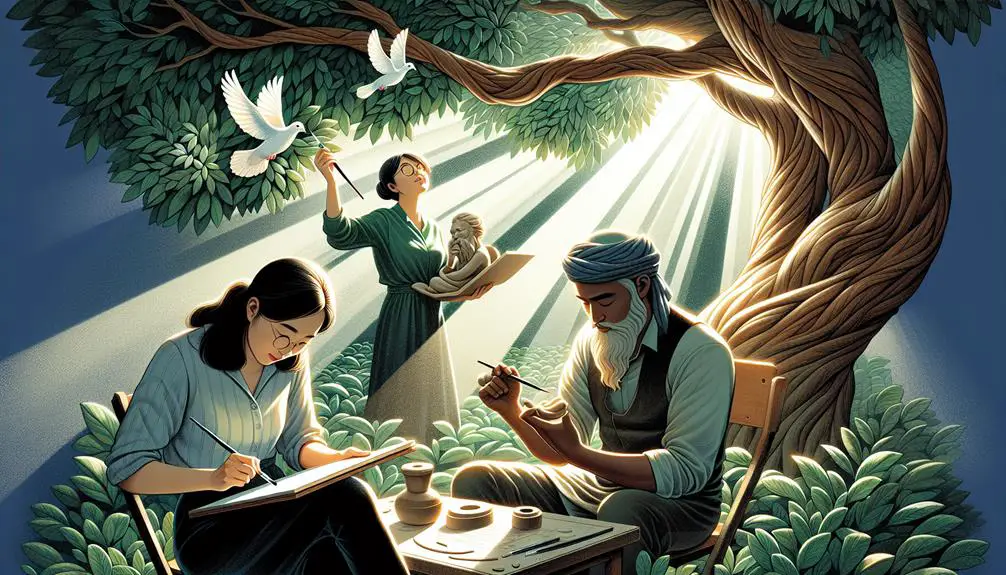
Creativity in the Bible
Consider the intricate design of the Tabernacle, as outlined in Exodus, showcasing an exceptional blend of divine instruction and human craftsmanship.
You're stepping into a realm where creativity isn't just encouraged; it's commanded and celebrated, bridging the gap between the spiritual and the tangible.
The Bible, often viewed through a purely religious lens, serves as a rich tapestry of artistic expression, from poetry in the Psalms to the vivid parables of Jesus.
As you explore further, you'll uncover layers of symbolic meaning and artistic brilliance that could redefine your understanding of creativity's role in faith.
Key Takeaways
- Biblical narratives, like Genesis and Job, showcase the foundational role of creativity in the divine and human experience.
- Symbolism and prophetic numbers in texts like Revelation reveal deep layers of meaning, inviting reflective interpretation.
- Artistic expressions in Psalms and Song of Songs highlight the enduring power of creativity in worship and human emotion.
- Interpreting biblical stories requires understanding their cultural and historical contexts to uncover timeless truths about creativity and divine inspiration.
Genesis: The Act of Creation

In Genesis, the act of creation showcases the foundational role of creativity as it unfolds the universe's inception through divine will. You're invited to ponder the profound depths of the creative process, as it bridges the ethereal and the material world.
This narrative doesn't simply recount the emergence of light, land, and life but delves into the essence of creativity itself. It's a vivid demonstration of how thought and word can manifest into physical reality, offering a reflection on our own potential to shape the material world around us.
This act of creation, as described, isn't a mere historical account; it's an invitation to understand the symbiotic relationship between the creator and the creation. It reveals that creativity isn't an isolated act but a continuous, dynamic interaction with the world.
You're led to appreciate that this creative process, while divine in its origin, mirrors the human capacity to innovate and transform our surroundings. Thus, Genesis not only narrates the inception of the universe but also serves as a profound commentary on the intrinsic value and power of creativity in shaping the material world.
The Psalms: Poetry and Worship
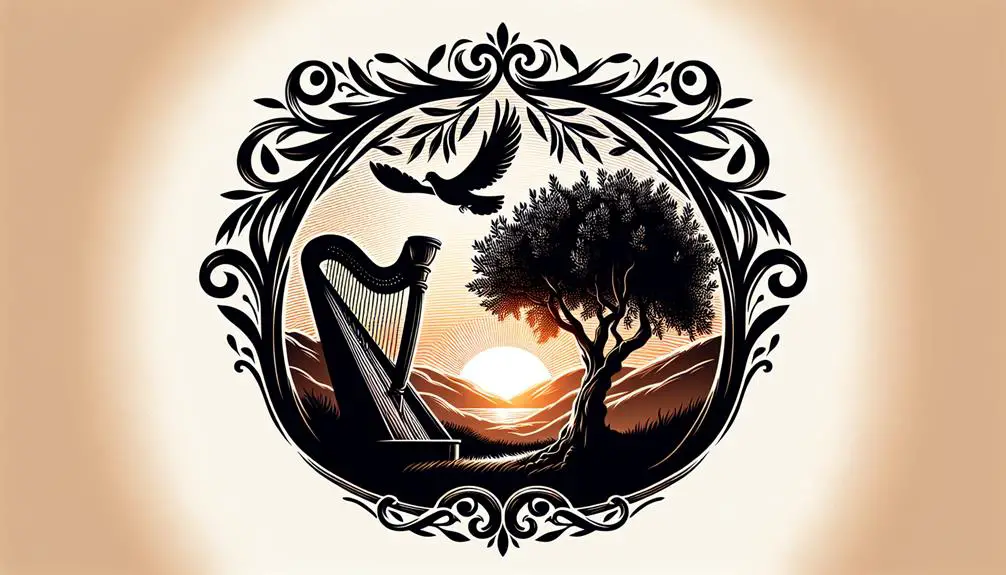
Exploring the Psalms reveals a rich tapestry of poetry and worship, deeply interwoven into the fabric of spiritual and communal life. These ancient songs and prayers encapsulate a myriad of human emotions, from the depths of despair to the heights of jubilation, showcasing an unparalleled emotional resonance. The Psalms serve not only as personal expressions of faith but also as communal hymns that have shaped worship practices across millennia.
The musical influence of the Psalms is undeniable. Composed with an intrinsic rhythmic and melodic quality, they have inspired countless musical settings, from ancient chants to contemporary worship music. This musical adaptation extends their reach and impact, illustrating the Psalms' timeless appeal and versatility.
Psalm |
Emotional Resonance |
Musical Influence |
|---|---|---|
23 |
Comfort |
Hymns and chants |
51 |
Repentance |
Penitential music |
150 |
Praise |
Choir anthems |
137 |
Lamentation |
Folk songs |
119 |
Devotion |
Recitals |
Through their poetic form and expressive depth, the Psalms invite you into a reflective journey, encouraging an exploration of the human condition in the presence of the divine. Their enduring legacy in both worship and art underscores the power of creative expression in fostering a deep, enduring connection with the sacred.
Parables of Jesus
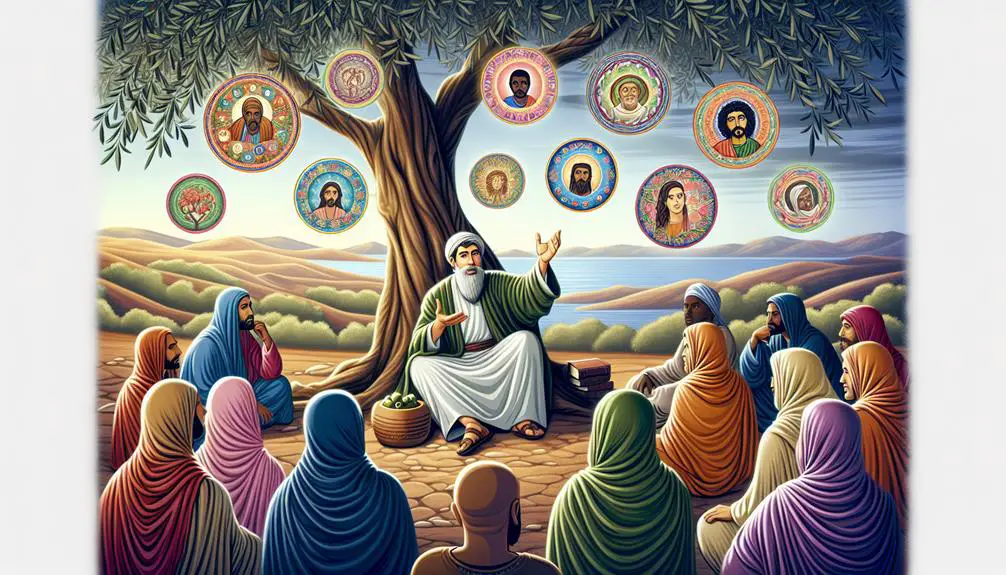
As you explore the creativity displayed in the Parables of Jesus, you'll notice that their interpretation requires a nuanced understanding of historical and cultural contexts.
These stories aren't just ancient texts; they resonate with modern-day relevance, challenging you to uncover the layers of meaning that speak to contemporary issues.
Parable Interpretation Techniques
One must approach the parables of Jesus with a blend of historical context and personal reflection to unlock their profound meanings. Understanding the historical context is paramount; it involves delving into the social, political, and economic conditions of the time. You're not just reading a story; you're immersing yourself in the lived experiences of those who first heard these teachings.
Cultural influences also play a crucial role. Recognizing the symbols, metaphors, and idiomatic expressions specific to the time can illuminate the parables' deeper lessons. This method requires you to wear the sandals of those in Jesus' era, seeing the world through their eyes.
Modern-day Parable Relevance
Delving into the parables of Jesus today, we uncover timeless truths that transcend cultural and temporal boundaries, offering profound insights into our contemporary lives. The adaptability of these parables allows for their retelling through digital storytelling, enhancing their relevance and accessibility. Cultural adaptation further ensures these stories resonate across diverse global audiences, providing ethical and moral guidance reflective of societal shifts.
Parable Theme |
Modern Application |
|---|---|
Sower and Seeds |
Media consumption habits |
Lost Sheep |
Social justice initiatives |
Prodigal Son |
Family reconciliation |
Good Samaritan |
Global humanitarian efforts |
Unforgiving Servant |
Debt forgiveness policies |
Analyzing these parables in today's context reveals their enduring wisdom, encouraging empathy, compassion, and understanding in a rapidly evolving digital age.
Symbolism in Revelation

As you explore the Symbolism in Revelation, you'll uncover the layers of apocalyptic imagery that serve as a canvas for depicting the end times.
Each prophetic number you encounter isn't arbitrary but holds a deeply encoded significance, reflecting the intricate design of biblical prophecy.
This journey into Revelation's symbols offers you a unique lens through which to view the culmination of biblical narrative, inviting a deeper reflection on its creative expression.
Apocalyptic Imagery Decoded
The Book of Revelation employs a rich tapestry of apocalyptic imagery, inviting readers to decode its complex symbolism and unearth the deeper meanings embedded within its narrative. This book intricately weaves symbols that echo the Old Testament, particularly drawing from Daniel's beasts and Ezekiel's visions.
You'll notice that these symbols aren't mere embellishments but serve as crucial keys to understanding the messages Revelation intends to convey. Daniel's beasts symbolize empires and kings, while Ezekiel's visions offer insights into divine judgment and restoration. Analyzing these symbols, you're not just reading ancient texts; you're engaging in a reflective journey through history, prophecy, and theology.
This scholarly exploration allows you to appreciate the creativity and depth of biblical literature, realizing that every symbol carries weight and significance in the broader biblical narrative.
Prophetic Numbers Explained
Building on the intricate symbolism found in Revelation, it's crucial to decode the prophetic numbers that further illustrate the text's depth and complexity. These numerical patterns aren't arbitrary; they're imbued with profound meaning, serving as conduits for angelic messages.
For instance, the number seven symbolizes completion and perfection, reflective of God's creation week. It recurs in the form of seven churches, seven seals, and seven trumpets, each sequence heralding a phase in the divine plan.
Similarly, the number twelve, representing God's people, is evident in the twelve tribes of Israel and the twelve apostles. By delving into these patterns, you're not just engaging with numbers. You're unlocking a celestial language, where each figure and sequence reveals layers of spiritual insight and divine orchestration.
The Prophets' Visions
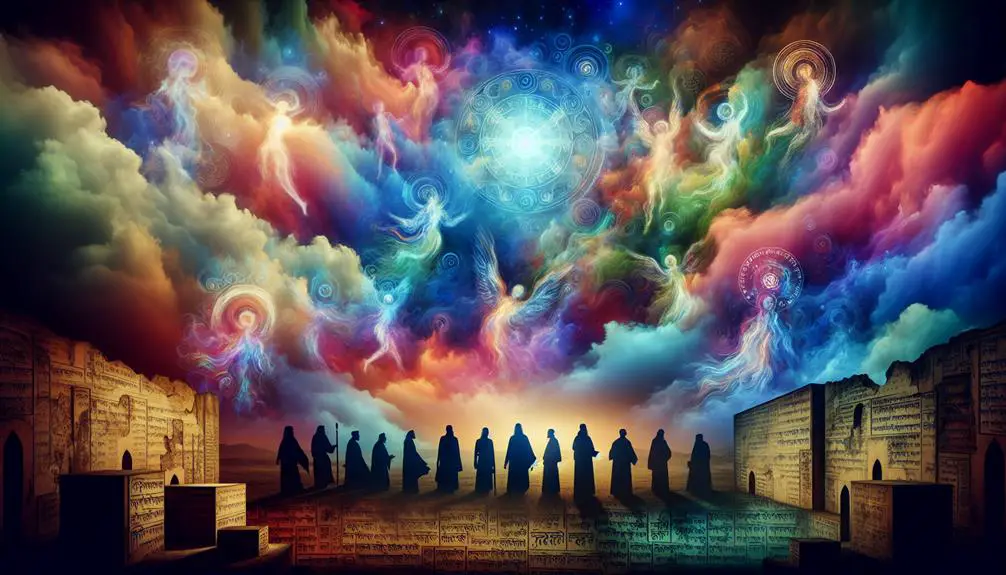
Within the tapestry of biblical narratives, prophets' visions stand out as vivid demonstrations of divine communication and creativity. When you delve into these visions, you're engaging with a realm where prophetic metaphors and vision interpretation intertwine, offering layers of meaning that transcend the immediate visual descriptions.
Prophet |
Vision |
Significance |
|---|---|---|
Isaiah |
Seraphim |
Symbolizes divine holiness and purification. |
Ezekiel |
Dry bones |
Represents the restoration of Israel. |
Daniel |
Statue |
Depicts successive world empires. |
Amos |
Plumb line |
Signifies the judgment of Israel. |
Zechariah |
Chariots |
Portrays divine surveillance and intervention. |
These visions, rich in symbolism, require a reflective and scholarly approach to unravel. They're not just about what the prophets saw but about what these sights conveyed in terms of divine messages. The ability to interpret these visions is crucial, as it bridges the gap between divine intention and human understanding. Through this lens, you're invited to appreciate the depth and breadth of creativity that these prophetic experiences bring to the biblical narrative, enriching its texture and expanding its interpretative horizons.
Artistic Imagery in Job

Exploring the Book of Job, you'll encounter a landscape adorned with artistic imagery that, much like the prophets' visions, reveals layers of meaning about human suffering and divine sovereignty. This biblical book uses vivid descriptions and metaphors to delve deep into the essence of Job's suffering and the omnipotence of God. The narrative doesn't just tell a story; it paints a picture, drawing you into a world where every word has weight and significance.
One of the most striking examples is the description of Leviathan. This passage isn't merely about a mythical creature; it's a masterful embodiment of chaos and power that defies human control. Through this imagery, you're invited to reflect on the nature of God's creation and the limits of human understanding. Leviathan's description serves as a metaphor for Job's suffering—vast, mysterious, and beyond human comprehension.
In reading Job, you're not just observing Job's trials; you're being asked to ponder the complexities of faith, the intricacies of divine justice, and the profound reality of human fragility. The artistic imagery woven throughout Job enriches your understanding, compelling you to look beyond the surface and explore the depths of spiritual truth.
The Tabernacle's Design
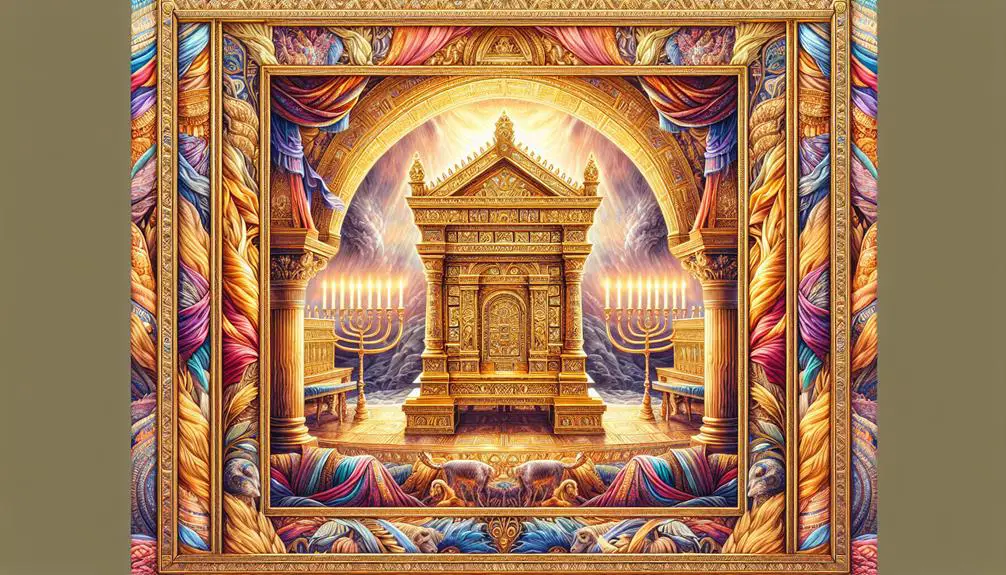
Transitioning from the poetic landscapes of Job to the Book of Exodus, we encounter the meticulous design of the Tabernacle, a symbol of divine presence and human-divine interaction that invites a deeper reflection on sacred space and worship. The craftsmanship details and material significance embedded within the Tabernacle's construction aren't merely ornamental; they serve as a profound dialogue between the divine and the earthly realms.
Each fabric thread, gold overlay, and acacia wood structure carries weight beyond their physical attributes, symbolizing layers of spiritual truths and ethical teachings. The precision in craftsmanship details reflects a divine order and an invitation to approach worship with the same dedication and care. This attention to detail in the Tabernacle's design underscores a theology of beauty where every element serves a purpose, leading worshippers toward a deeper understanding of their relationship with the divine.
Moreover, the material significance—gold representing purity and value, fine linen symbolizing righteousness—enriches this narrative, teaching that the materials we bring into sacred spaces matter. They're not just functional; they're symbolic, echoing the interconnectedness of the material and the spiritual. Through the Tabernacle's design, the Bible creatively communicates a vision of worship that's both grounded and transcendent, inviting reflection on how we construct our own spaces of worship today.
Song of Songs: Love's Poetry

Shifting our focus from the tangible expressions of worship in the Tabernacle's design, we now encounter the intangible yet profound expressions of divine and human love in the Song of Songs. This unique book of the Bible stands out for its rich use of erotic metaphor within a sacred text, offering a deep exploration of love's complexity.
- The erotic metaphor used challenges us to consider love's depth, transcending mere physical attraction to embody a spiritual and emotional union.
- Understanding the cultural context of ancient Near Eastern love poetry illuminates the Song's richness, highlighting its innovative approach to expressing love.
- The poetry blurs the lines between divine and human love, suggesting that experiencing love in its fullest form can be a pathway to understanding the divine.
- The Song's inclusivity and affirmation of mutual desire contrast with other contemporaneous cultural norms, presenting a forward-thinking viewpoint on gender and equality in relationships.
- Its vivid imagery and passionate expressions serve not only as an ode to love but also as a testament to the creative power of language to capture the ineffable.
Analyzing the Song of Songs opens a window into the ancient world's perception of love, emphasizing the enduring power of creativity to explore and celebrate the most profound human experiences.
Frequently Asked Questions
How Do Modern Artists and Creators Draw Inspiration From the Narratives and Themes Found in the Bible, Particularly Those Not Directly Related to Traditional Religious Art?
You're exploring how modern creators tap into ancient texts for inspiration, steering clear of overtly religious themes. They dive deep into symbolic imagery and moral conflicts, drawing parallels to today's societal issues.
This approach allows them to craft narratives that resonate on a human level, reflecting on themes of redemption, struggle, and hope. By analyzing these elements, they bridge the gap between ancient wisdom and contemporary creative expression, enriching their work with layers of meaning.
In What Ways Have the Creative Aspects of the Bible Influenced Contemporary Music, Literature, and Film That Don't Explicitly Reference Biblical Stories or Characters?
You've likely noticed how contemporary music, literature, and film often resonate with unspoken depths. These works frequently draw on musical motifs and allegorical influences that, while not explicitly citing biblical stories or characters, reflect the Bible's creative aspects.
This subtle integration enriches narratives, adding layers of meaning and complexity. Whether through thematic parallels or moral quandaries, creators weave biblical creativity into the fabric of modern storytelling, offering audiences a richer, more reflective experience.
How Do Different Cultural Interpretations of the Bible's Creative Content Impact the Way These Stories Are Told and Retold in Art and Media Across the World?
You're exploring how cultural storytelling and interpretive diversity shape the narratives derived from a foundational text.
This process involves analyzing the myriad ways in which different cultures absorb, adapt, and reframe these stories within their unique context, affecting their representation in art and media globally.
It's a reflection on the dynamic interaction between cultural identity and narrative tradition, highlighting how universal themes are tailored to resonate with diverse audiences.
Can the Principles of Creativity Observed in the Bible Be Applied to Problem-Solving and Innovation in Fields Outside of the Arts, Such as Science, Technology, and Business?
Absolutely, you can apply biblical creativity principles to other fields like science, technology, and business. Think of it as using Design Thinking to innovate responsibly.
You're not just creating for the sake of it; you're reflecting on Innovation Ethics, ensuring your work benefits society. It's about solving problems thoughtfully, considering the impact.
How Do Non-Religious Readers and Creators Engage With the Creative Elements of the Bible, and What Relevance Do These Elements Have for Audiences Without a Religious Background?
You're navigating through time, exploring literary masterpieces. While dissecting texts, you encounter the Bible. It's not just a religious artifact but a treasure trove of narratives ripe for literary analysis. Non-religious readers like you find ethical parallels that resonate universally, making the Bible's creativity relevant.
This engagement transcends faith, illuminating paths for innovation and reflection in our modern world. Its stories spark discussions, fuel debates, and inspire across diverse fields.
Conclusion
As you've journeyed through the tapestry of creativity woven into the Bible's fabric, you've seen how its threads—from Genesis to Revelation—craft a mosaic of divine expression.
This spiritual palette, rich with poetic landscapes, visionary prophecies, and symbolic architecture, invites you to explore the depths of your own creativity.
Like a potter shaping clay, the Bible molds the imagination, offering a reflection on the divine artistry that shapes our lives and faith, guiding us toward a deeper understanding of the Creator's masterpiece.

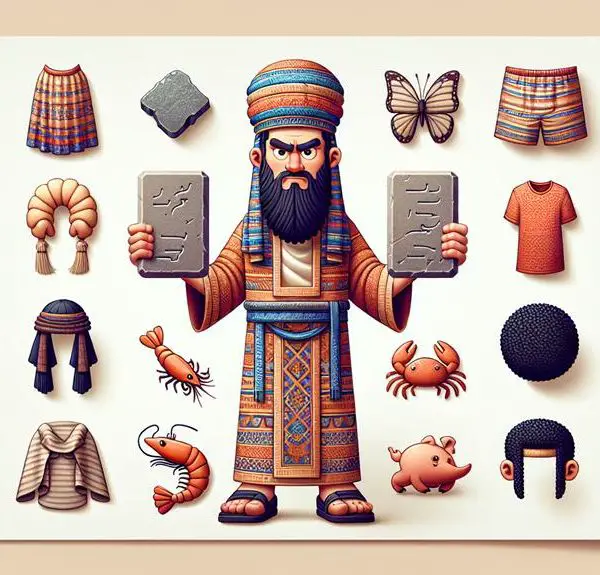

Sign up